Lithofacies Characteristics and Their Effects on Shale Oil Enrichment: A Case Study from Shahejie Formation of the Qibei Sag, Bohai Bay Basin, China
Abstract
1. Introduction
2. Geological Setting
3. Materials and Methods
4. Results
4.1. Mineral Composition and Content of Mud Shale
4.2. Macro and Microstructure of Mud Shale
4.3. Classification of Lithofacies
4.3.1. Lithofacies of Thin Laminar Shale
4.3.2. Lithofacies of Thick Laminar Shale
4.3.3. Lithofacies of Massive Mudstone
4.3.4. Lithofacies of Argillaceous Siltstone
4.4. Longitudinal Distribution of Lithofacies
4.5. Pore Characteristics in the Mud Shale
4.6. Residual Hydrocarbon Content in the Mud Shale
5. Discussion
5.1. Effect of Shale Lithofacies on Shale Oil Content
5.2. Effect of the Source-Reservoir Relationship on Shale Oil Enrichment
6. Conclusions
Author Contributions
Funding
Data Availability Statement
Conflicts of Interest
References
- EIA. Annual Energy Outlook. 2021. Available online: http://www.eia.gov/outlooks (accessed on 14 January 2021).
- Ma, Y.; Cai, X.; Zhao, P.; Hu, Z.; Liu, H.; Gao, B.; Wang, W. Geological characteristics and exploration practices of continental shale oil in China. Acta Geol. Sin. 2022, 96, 155–171. [Google Scholar]
- Li, M.; Ma, X.; Jiang, Q.; Li, Z.; Pang, X.; Zhang, C. Enlightenment from formation conditions and enrichment characteristics of marine shale oil in North America. Pet. Geol. Recovery Effic. 2019, 26, 13–28. [Google Scholar]
- Zhang, T.; Peng, Z.; Yang, W.; Ma, Y.; Zhang, J. Enlightenments of American shale oil research towards China. Lithol. Reserv. 2015, 27, 1–10. [Google Scholar]
- Wang, G.; Carr, T.R. Organic-rich Marcellus Shale lithofacies modeling and distribution pattern analysis in the Appalachian Basin. AAPG Bull. 2013, 97, 2173–2205. [Google Scholar] [CrossRef]
- Zhao, W.; Hu, S.; Hou, L.; Yang, T.; Li, X.; Guo, B.; Yang, Z. Types and resource potential of continental shale oil in China and its boundary with tight oil. Pet. Explor. Dev. 2020, 47, 1–10. [Google Scholar] [CrossRef]
- Hu, S.; Bai, B.; Tao, S.; Bian, C.; Zhang, T.; Chen, Y.; Liang, X. Heterogeneous geological conditions and differential enrichment of medium and high maturity continental shale oil in China. Pet. Explor. Dev. 2022, 49, 224–237. [Google Scholar] [CrossRef]
- Xiao, W.; Zhang, B.; Yao, Y.; Wang, Y.; Yang, H.; Yang, K. Lithofacies and sedimentary environment of shale of Permian Longtan Formation in eastern Sichuan Basin. Lithol. Reserv. 2022, 34, 152–162. [Google Scholar]
- Kang, J.; Wang, X.; Xie, S.; Zeng, D.; Du, H.; Zhang, R.; Zhang, S. Lithofacies types and reservoir characteristics of shales of Jurassic Da’anzhai member in central Sichuan Basin. Lithol. Reserv. 2022, 34, 53–65. [Google Scholar]
- Teichert, C. Concepts of facies. AAPG Bull. 1958, 42, 2718–2744. [Google Scholar]
- Song, Z.; Li, J.; Li, X.; Chen, K.; Wang, C.; Li, P.; Wei, Y.; Zhao, R.; Wang, X.; Zhang, S.; et al. Coupling Relationship between Lithofacies and Brittleness of the Shale Oil Reservoir: A Case Study of the Shahejie Formation in the Raoyang Sag. Geofluids 2022, 2022, 2729597. [Google Scholar] [CrossRef]
- Liu, B.; Wang, H.; Fu, X.; Bai, Y.; Jia, M.; He, B. Lithofacies and depositional setting of a highly prospective lacustrine shale oil succession from the Upper Cretaceous Qingshankou Formation in the Gulong sag, northern Songliao Basin, northeast China. AAPG Bull. 2019, 103, 405–432. [Google Scholar] [CrossRef]
- Gao, F.; Song, Y.; Li, Z.; Xiong, F.; Lei, C.; Zhang, Y.; Liang, Z. Lithofacies and reservoir characteristics of the Lower Cretaceous continental Shahezi Shale in the Changling Fault Depression of Songliao Basin, NE China. Mar. Pet. Geol. 2018, 98, 401–421. [Google Scholar] [CrossRef]
- Sun, L.; Liu, H.; He, W.; Li, G.; Zhang, S.; Zhu, R.; Jin, X. An analysis of major scientific problems and research paths of Gulong shale oil in Daqing Oilfield, NE China. Pet. Explor. Dev. 2021, 48, 453–463. [Google Scholar] [CrossRef]
- Jin, C.; Dong, W.; Bai, Y.; Lv, J.; Fu, X.; Li, J.; Ma, S. Lithofacies characteristics and genesis analysis of Gulong shale in Songliao Basin. Pet. Geol. Oilfield Dev. Daqing 2020, 39, 35–44. [Google Scholar]
- Wang, Y.; Liang, J.; Zhang, J.; Zhao, B.; Zhao, Y.; Liu, X.; Xian, D. Resource potential and exploration direction of Gulong shale oil in Songliao Basin. Pet. Geol. Oilfield Dev. Daqing 2020, 39, 20–34. [Google Scholar]
- Zhao, X.; Zhou, L.; Pu, X.; Jin, F.; Shi, Z.; Han, W.; Jiang, W. Formation conditions and enrichment model of retained petroleum in lacustrine shale: A case study of the Paleogene in Huanghua depression, Bohai Bay Basin, China. Pet. Explor. Dev. 2020, 47, 856–869. [Google Scholar] [CrossRef]
- Zhao, X.; Zhou, L.; Pu, X.; Shi, Z.; Han, G.; Wu, J.; Han, W. Geological characteristics and exploration breakthrough of shale oil in Member 3 of Shahejie Formation of Qibei subsag, Qikou sag. Acta Pet. Sin. 2020, 41, 643–657. [Google Scholar]
- Zhou, L.; Han, G.; Yang, F.; Ma, J.; Mou, L.; Zhou, K.; Wang, C. Geological characteristics and shale oil exploration of Es 3 in Qikou Sag, Bohai Bay Basin. Oil Gas Geol. 2021, 42, 443–454. [Google Scholar]
- Sun, Z.; Wang, F.; Han, Y.; Hou, Y.; He, S.; Luo, J.; Zheng, Y. Multi-scale characterization of the spatial distribution of movable hydrocarbon in intersalt shale of Qianjiang Formation, Qianjiang Sag, Jianghan Basin. Pet. Geol. Exp. 2020, 42, 586–595. [Google Scholar]
- Zhou, L.; Chen, C.; Han, G.; Yang, F. Difference Characteristics between Continental Shale Oil and Tight Oil and Exploration Practice: A Case from Huanghua Depression, Bohai Bay Basin. Earth Sci. 2021, 46, 555–571. [Google Scholar]
- Han, G.; Si, W.; Shi, Q.; Zhang, L.; Zhou, K.; Wang, Y. Conditions of Lithologic reservoir formation and favorable selection of exploration area in North Slope of Qikou Sag. Nat. Gas Geosci. 2010, 21, 594–600. [Google Scholar]
- Zhao, X.; Pu, X.; Wang, J.; Zhou, L.; Jin, F.; Xiao, D.; Jiang, W. Sand and reservoir controlling mechanism and exploration discovery in the gentle slope of fault basin: A case study of Qibei slope in Qikou sag. Pet. Explor. Dev. 2017, 38, 729–739. [Google Scholar]
- Zhou, L.; Chen, C.; Han, G.; Yang, F.; Ma, J.; Zhou, K.; Zhang, W. Geological characteristics and shale oil exploration potential of lower first member of Shahejie Formation in Qikou Sag, Bohai Bay Basin. Earth Sci. 2019, 44, 2736–2750. [Google Scholar]
- Liu, H.; Hu, S.; Li, J.; Wang, J.; Wang, Q.; Jiang, W.; Jiang, T. Controlling factors of shale oil enrichment and exploration potential in Lacustrine Bohai Bay Basin. Nat. Gas Geosci. 2019, 30, 1190–1198. [Google Scholar]
- Han, W.; Zhao, X.; Jin, F.; Pu, X.; Chen, S.; Mou, L.; Zhang, W. Sweet spots evaluation and exploration of lacustrine shale oil of the second member of Paleogene Kongdian Formation in Cangdong Sag, Bohai Bay Basin. Pet. Explor. Dev. 2021, 48, 777–786. [Google Scholar] [CrossRef]
- Gong, K.; Jiao, F.; Chen, Y.; Liu, X.; Pan, X.; Han, X.; Hou, X. Insights into the Site-Selective dsorption of Methanol and Water in Mordenite Zeolite by 129Xe NMR Spectroscopy. J. Phys. Chem. C 2019, 123, 17368–17374. [Google Scholar] [CrossRef]
- Peng, L.; Zhang, C.; Ma, H.; Pan, H. Estimating irreducible water saturation and permeability of sandstones from nuclear magnetic resonance measurements by fractal analysis. Mar. Pet. Geol. 2019, 110, 565–574. [Google Scholar] [CrossRef]
- O’Brien, N.R. Shale lamination and sedimentary processes. Geol. Soc. 1996, 116, 23–36. [Google Scholar] [CrossRef]
- Ingram, R.L. Terminology for the thickness of stratification and parting units in sedimentary rocks. GSA Bull. 1954, 65, 937–938. [Google Scholar] [CrossRef]
- Campbell, C.V. Lamina, laminaset, bed and bedset. Sedimentology 1967, 8, 7–26. [Google Scholar] [CrossRef]
- Liu, G.; Huang, Z.; Jiang, Z.; Chen, J.; Chen, C.; Gao, X. The characteristic and reservoir significance of lamina in shale from Yanchang Formation of Ordos Basin. Nat. Gas Geosci. 2015, 26, 408–417. [Google Scholar]
- Bian, C.; Zhao, W.; Yang, T.; Liu, W.; Dai, C.; Zeng, X.; Wang, K.; Li, Y.; Xiao, D. The Impact of Lamina Characteristics and Types on Organic Matter Enrichment of Chang 73 Submember in Ordos Basin, NW China. Geofluids 2022, 2022, 6558883. [Google Scholar] [CrossRef]
- He, J.; Ding, W.; Fu, J.; Li, A.; Dai, P. Study on genetic type of micropore in shale reservoir. Lithol. Reserv. 2014, 26, 30–35. [Google Scholar]
- Sun, W.; Li, W.; Dong, Z.; Yan, X.; Li, Y.; Li, S. A new approach to the characterization of shale pore structure. Lithol. Reserv. 2017, 29, 125–130. [Google Scholar]
- Lu, S.; Li, J.; Zhang, P.; Xue, H.; Wang, G.; Zhang, J.; Liu, H. Classification of microscopic pore-throats and the grading evaluation on shale oil reservoirs. Pet. Explor. Dev. 2018, 45, 436–444. [Google Scholar] [CrossRef]
- Wang, W.; Lu, S.; Tian, W.; Li, J.; Tian, N.; Shan, J.; Hu, Y. Liaohe Oilfield shale reservoir quality grading with micropore evaluation parameters in Damintun Depression. J. China Univ. Pet. 2016, 40, 12–19. [Google Scholar]
- Du, X.; Jin, Z.; Zeng, L.; Li, S.; Liu, G. Development characteristics and controlling factors of natural fractures in Chang 7 shale oil reservoir, Longdong Area, Ordos Basin. Earth Sci. 2022, 1–17. [Google Scholar]
- Wang, R.; Hu, Z.; Zhou, T.; Bao, H.; Wu, Q.; Du, W.; He, J. Characteristics of fractures and their significance for reservoirs in Wufeng-Longmaxi shale, Sichuan Basin and its periphery. Oil Gas Geol. 2021, 42, 1295–1306. [Google Scholar]
- Jiang, Q.; Li, M.; Qian, M.; Li, Z.; Li, Z.; Huang, Z.; Ma, C. Quantitative characterization of shale oil in different occurrence states and its application. Pet. Geol. Exp. 2016, 38, 842–849. [Google Scholar]
- Tian, S. Micro-Pore Characteristics of Shale Reservoirs and Evaluation of Shale Oil Occurrence and Movability. Ph.D. Thesis, China University of Petroleum (East China), Dongying, China, 2019; 154p. [Google Scholar]
- Feng, G.; Li, J.; Liu, J.; Zhang, X.; Yu, Z.; Tan, J. Discussion on the enrichment and mobility of continental shale oil in Biyang Depression. Oil Gas Geol. 2019, 40, 1236–1336. [Google Scholar]
- Liu, K.; Lu, X.; Gui, N.; Fan, J.; Gong, Y.; Li, X. Quantitative Fluoresence Techniques and their Applications in Hydrocarbon Accumulation Studies. Earth Sci. 2016, 41, 373–384. [Google Scholar]

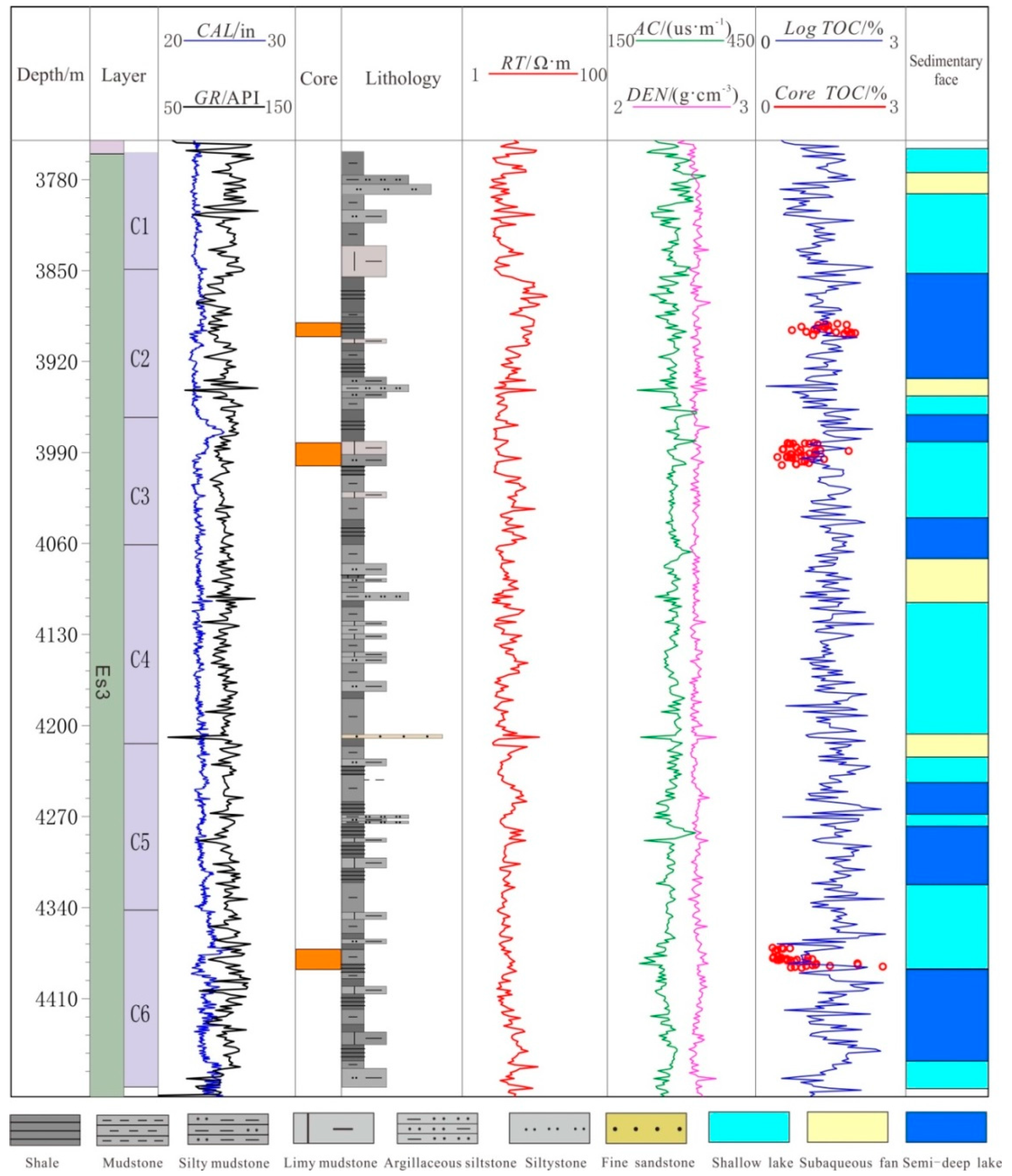
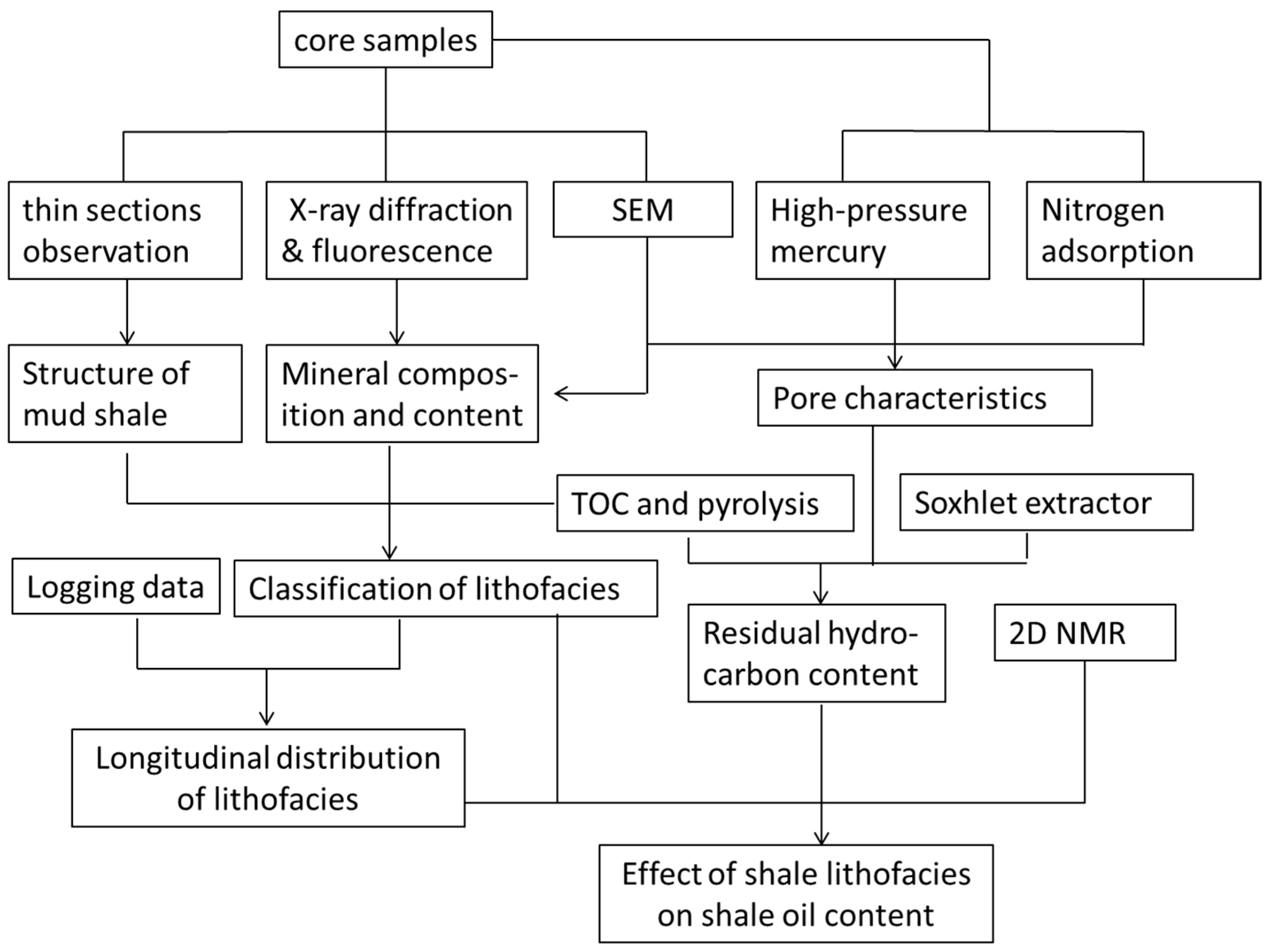
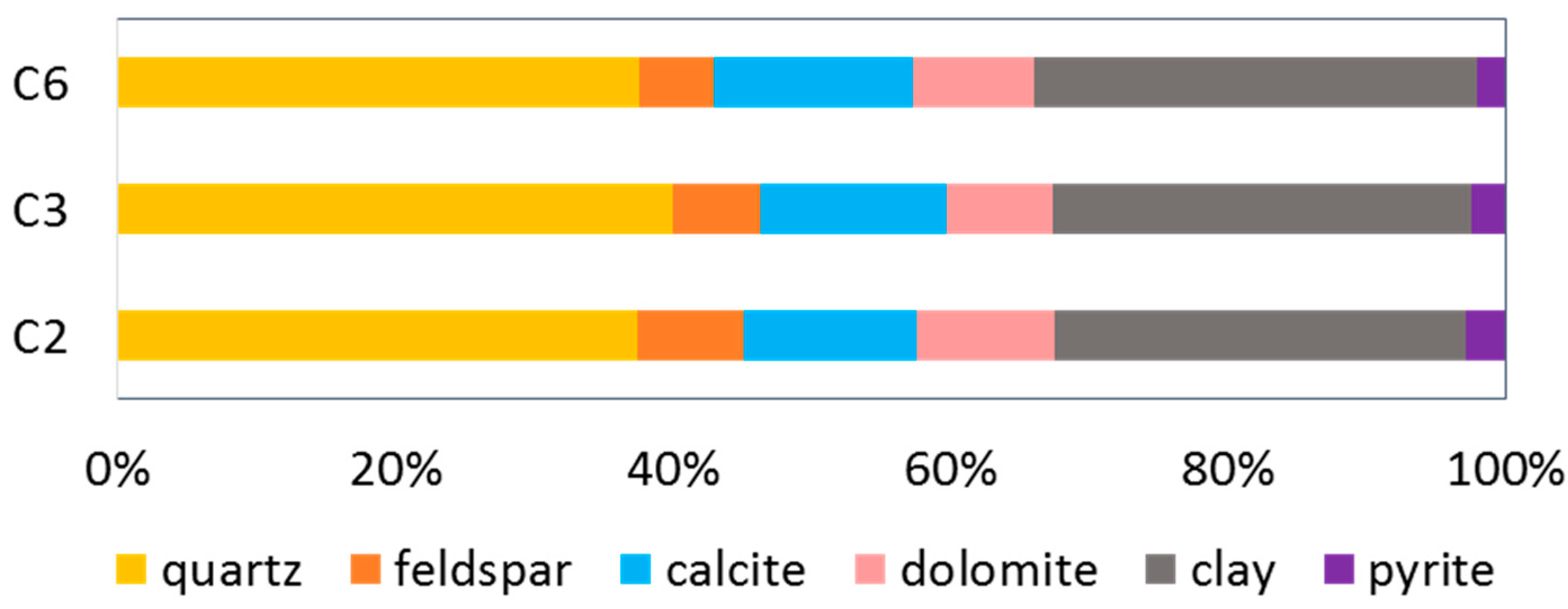
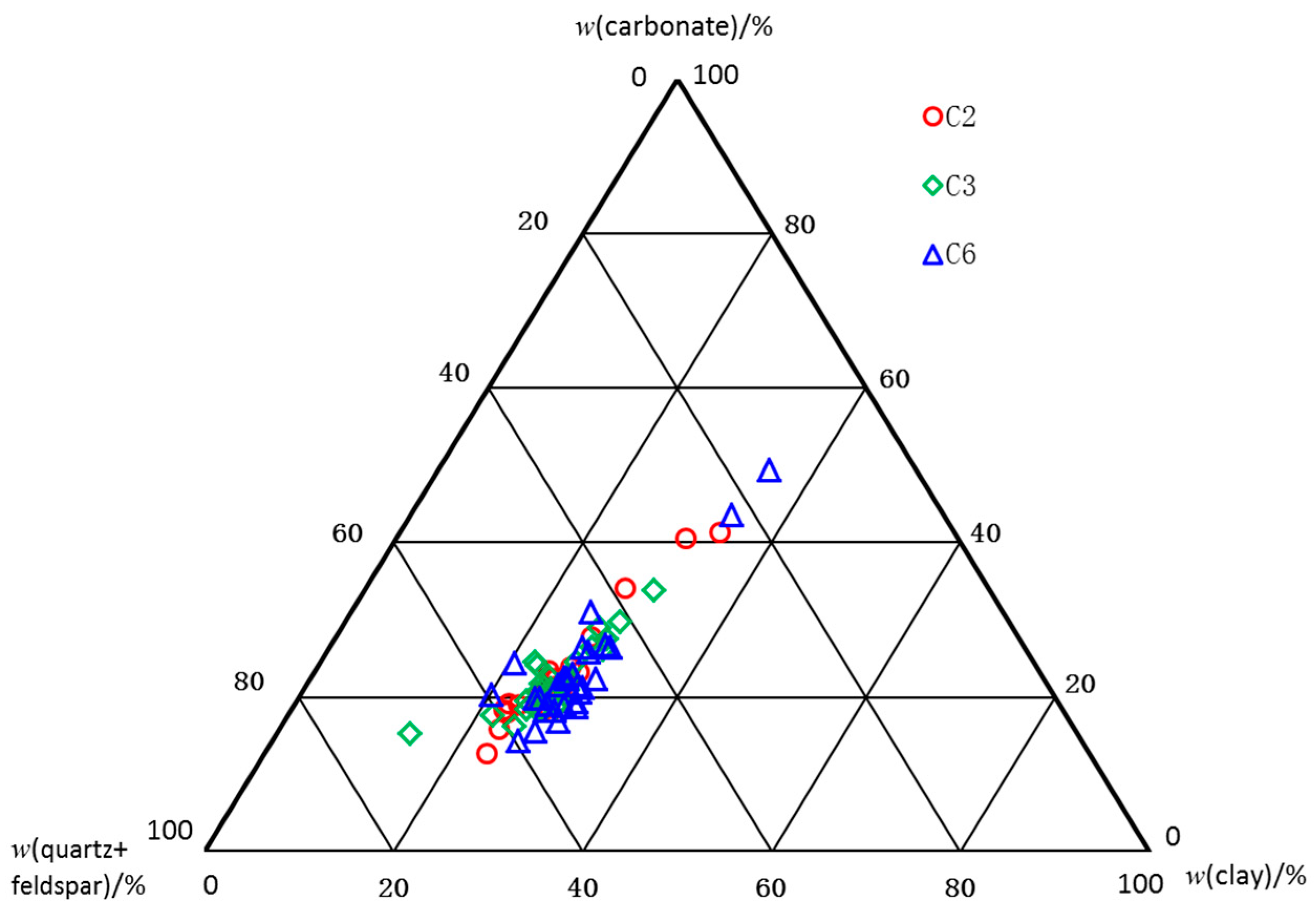

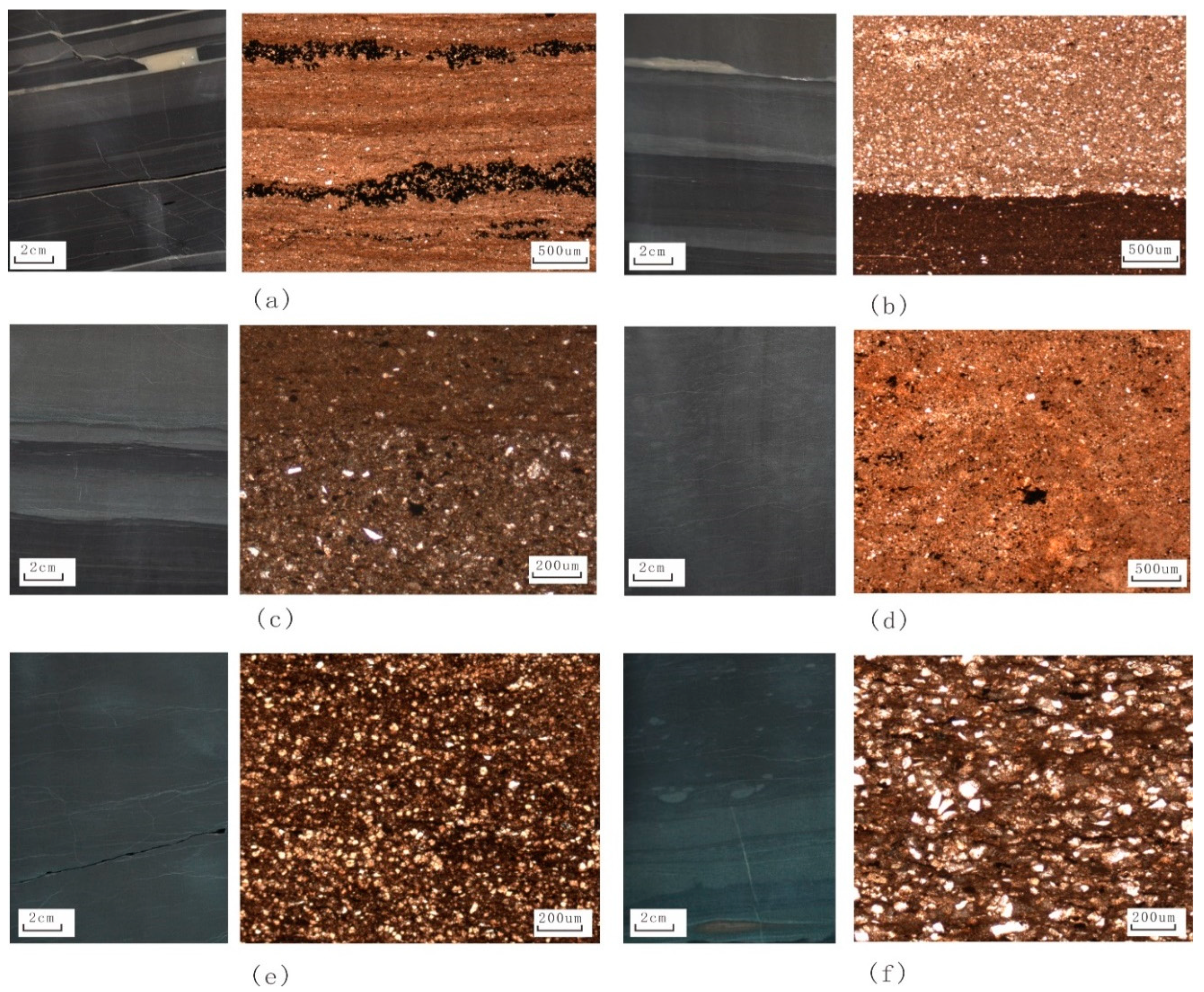
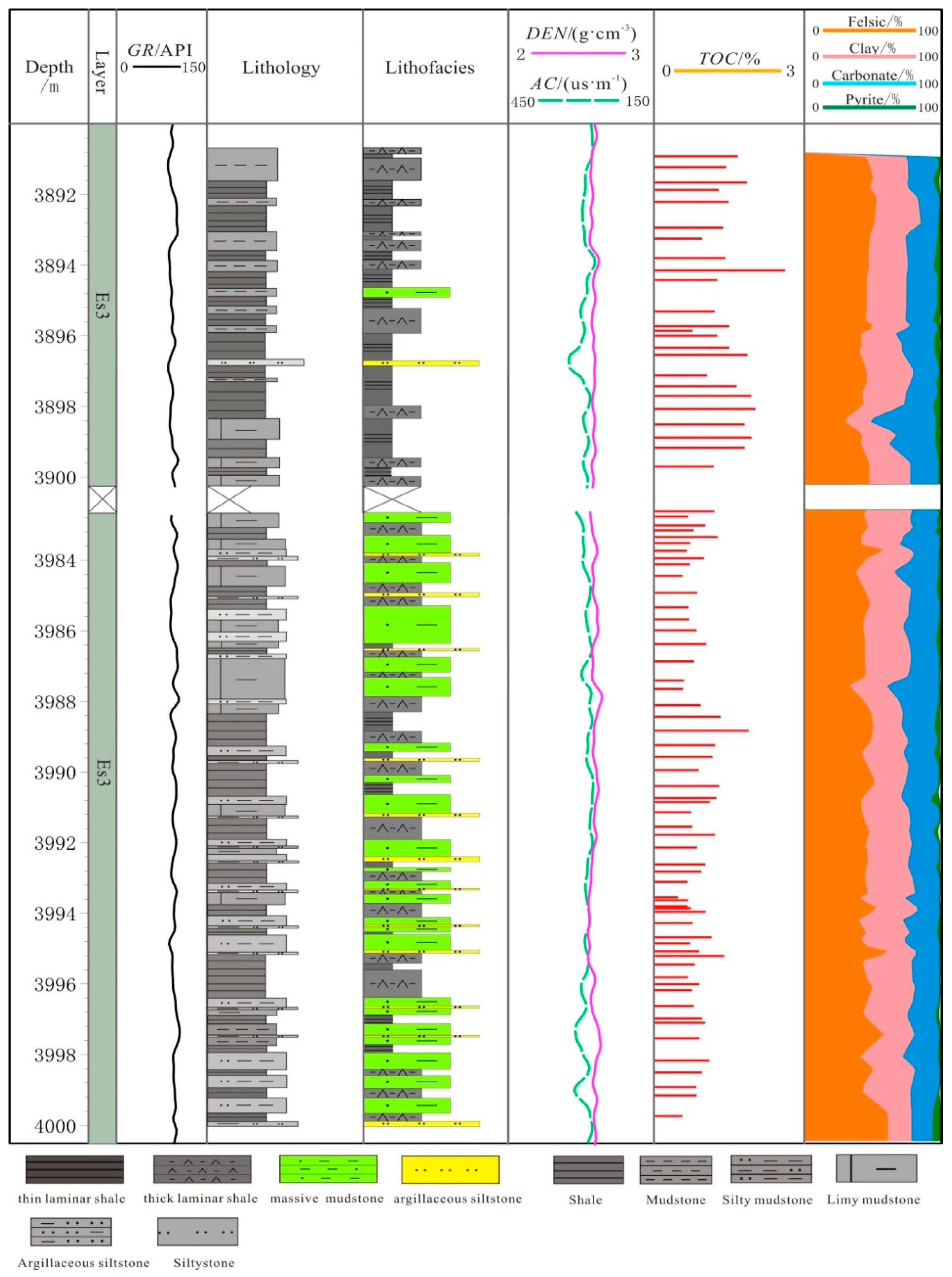
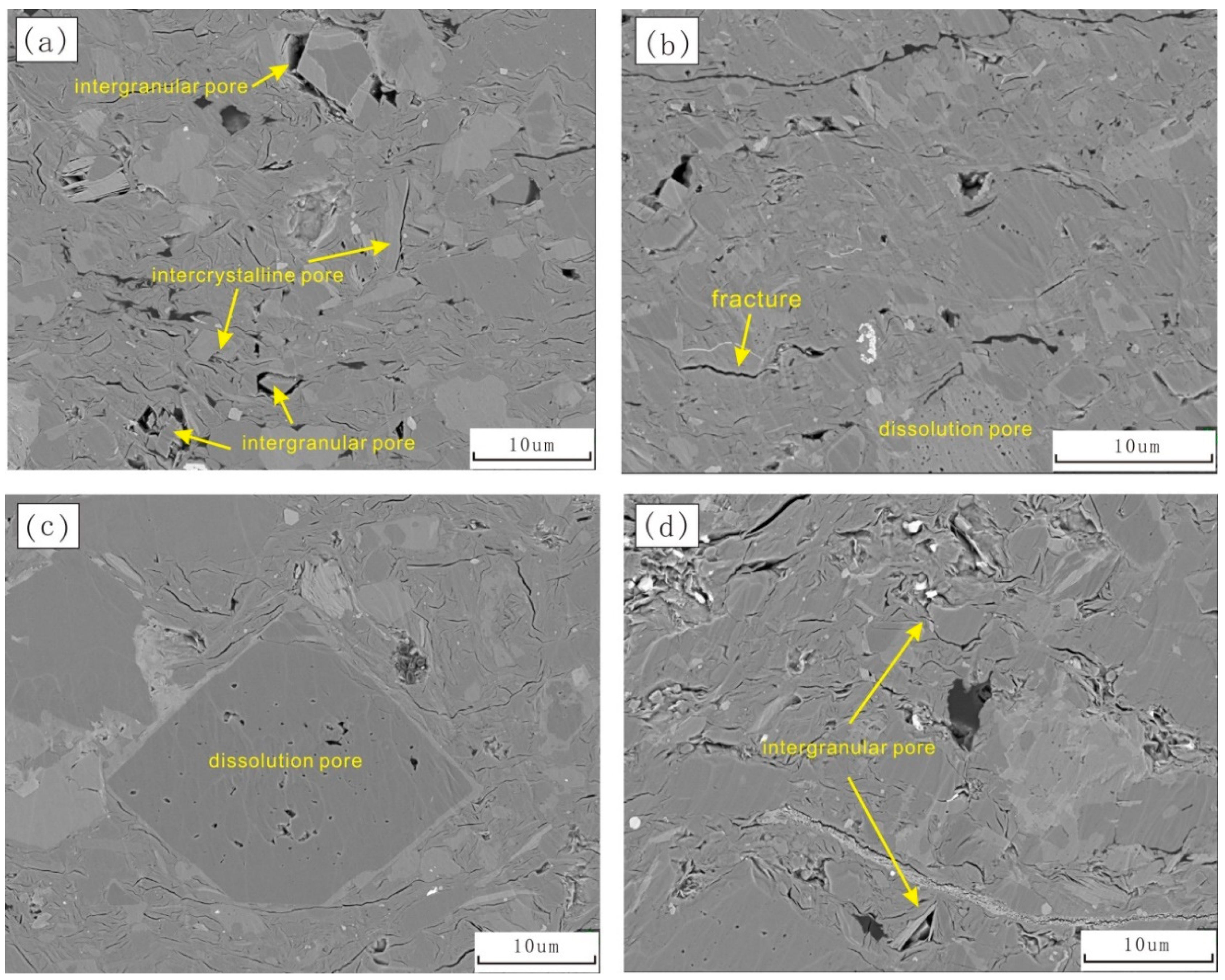
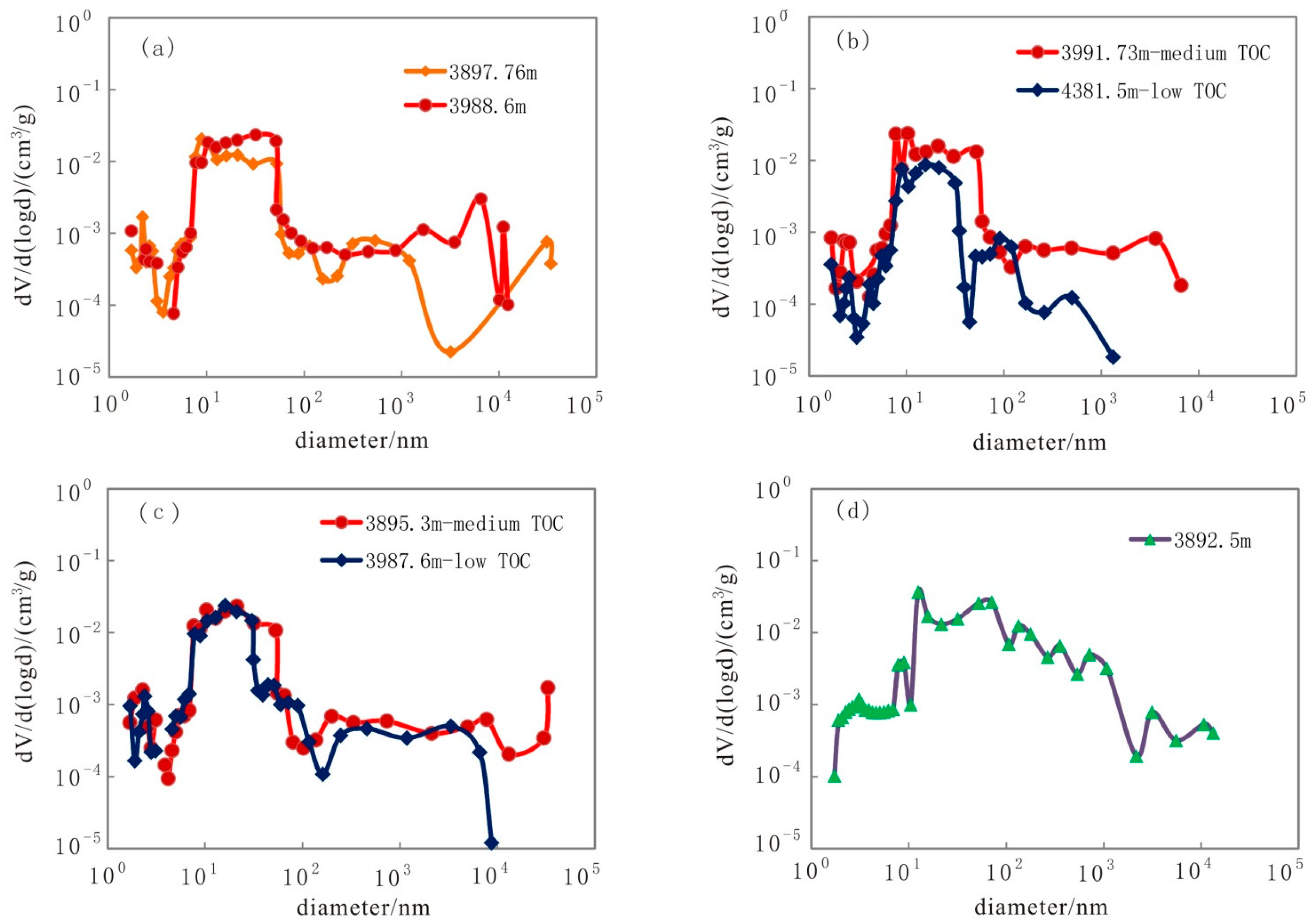
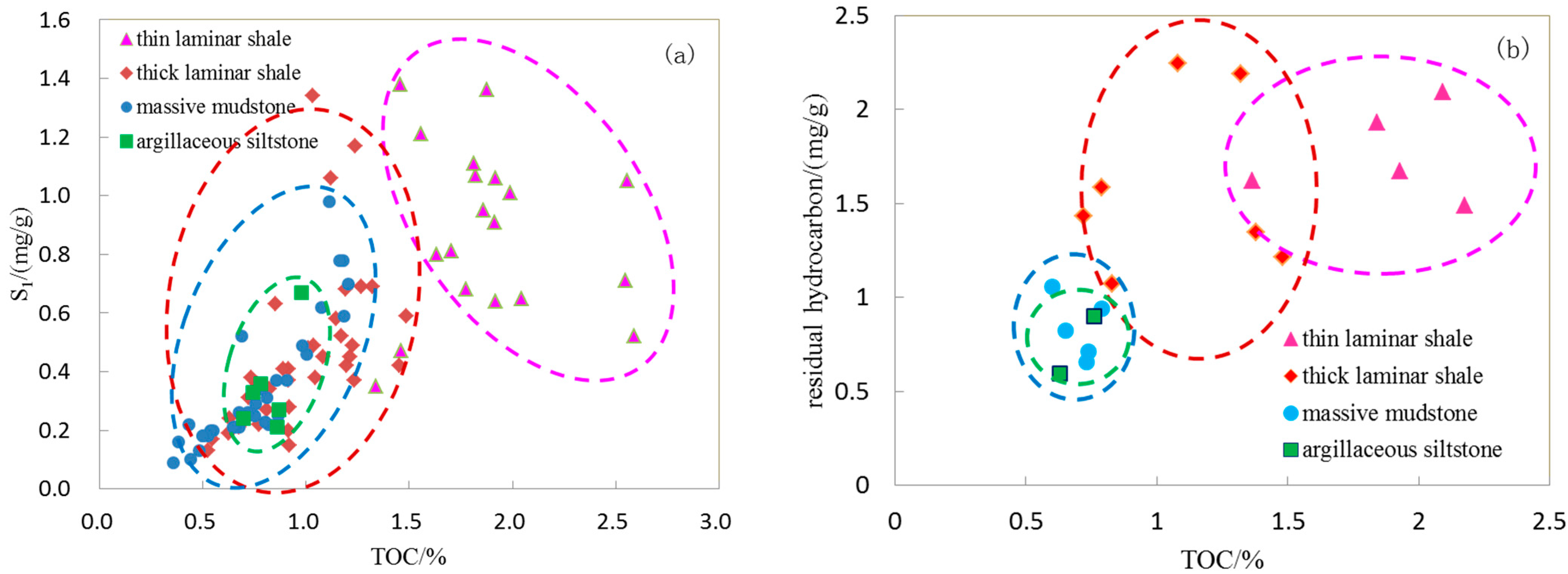
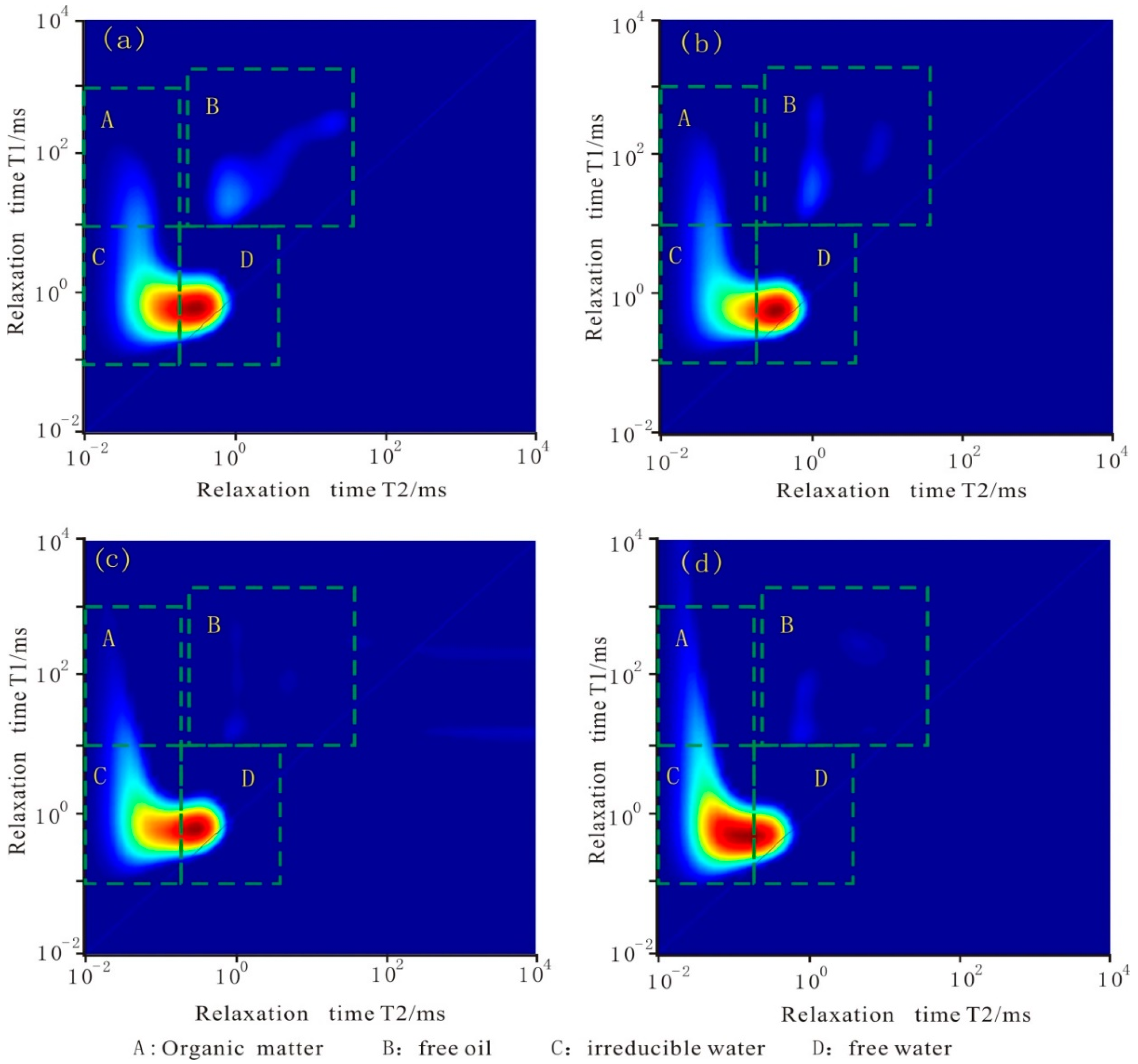

| Lithofacies Type | Structure Characteristic | Abundance of Organic Matter | Mineral Content of Lamina | |
|---|---|---|---|---|
| Thin laminar shale | Dark gray laminae development, a single layer thickness < 1 cm | TOC content > 1.0% | Composed of felsic and clay minerals, with high pyrite content | |
| Thick laminar shale | Medium organic matter thick laminar shale | composed of light and dark laminar interbedding, a single layer thickness >1 cm | TOC content > 1.0% | bright lamina is light gray felsic, and dark lamina is dark gray organic rich clay mineral |
| Low organic matter thick laminar shale | Composed of light and dark laminar interbedding, light laminae are higher, a single layer thickness >1 cm in average | TOC content < 1.0% | The thickness of dark lamina is significantly lower than that of bright layer | |
| Massive mudstone | Medium organic matter massive mudstone | gray Massive, lamina is not development | TOC content > 1.0% | Felsic and clay minerals are distributed randomly |
| low organic matter massive mudstone | Gray-yellow gray massive, lamina is not development | TOC content < 1.0% | The content of calcite or dolomite is relatively high | |
| Argillaceous siltstone | Light gray bedded, silt texture | TOC content < 1.0% | The content of felsic is usually greater than 50% | |
| Lithofacies | Quartz | Feldspar | Clay | Carbonate | Pyrite | Organic Atter |
|---|---|---|---|---|---|---|
| Thin laminar shale | 38 | 6.4 | 28 | 23.2 | 3.8 | 1.6 |
| Medium organic matter thick laminar shale | 37.5 | 5.7 | 31 | 23.4 | 2.2 | 1.2 |
| Low organic matter thick laminar shale | 38.7 | 5.8 | 33.9 | 20 | 1.2 | 0.8 |
| Medium organic matter massive mudstone | 40.6 | 5.4 | 29.6 | 20.7 | 3 | 1.1 |
| Low organic matter massive mudstone | 37.7 | 6.2 | 32.8 | 20.8 | 1.5 | 0.6 |
| Argillaceous siltstone | 42 | 10.4 | 28 | 18.3 | 1.1 | 0.8 |
Disclaimer/Publisher’s Note: The statements, opinions and data contained in all publications are solely those of the individual author(s) and contributor(s) and not of MDPI and/or the editor(s). MDPI and/or the editor(s) disclaim responsibility for any injury to people or property resulting from any ideas, methods, instructions or products referred to in the content. |
© 2023 by the authors. Licensee MDPI, Basel, Switzerland. This article is an open access article distributed under the terms and conditions of the Creative Commons Attribution (CC BY) license (https://creativecommons.org/licenses/by/4.0/).
Share and Cite
Bian, C.; Guo, B.; Pu, X.; Zeng, X.; Liu, W.; Li, Y.; Zhou, K.; Tian, Q.; Ma, C. Lithofacies Characteristics and Their Effects on Shale Oil Enrichment: A Case Study from Shahejie Formation of the Qibei Sag, Bohai Bay Basin, China. Energies 2023, 16, 2107. https://doi.org/10.3390/en16052107
Bian C, Guo B, Pu X, Zeng X, Liu W, Li Y, Zhou K, Tian Q, Ma C. Lithofacies Characteristics and Their Effects on Shale Oil Enrichment: A Case Study from Shahejie Formation of the Qibei Sag, Bohai Bay Basin, China. Energies. 2023; 16(5):2107. https://doi.org/10.3390/en16052107
Chicago/Turabian StyleBian, Congsheng, Bincheng Guo, Xiugang Pu, Xu Zeng, Wei Liu, Yongxin Li, Kejia Zhou, Qianhui Tian, and Chao Ma. 2023. "Lithofacies Characteristics and Their Effects on Shale Oil Enrichment: A Case Study from Shahejie Formation of the Qibei Sag, Bohai Bay Basin, China" Energies 16, no. 5: 2107. https://doi.org/10.3390/en16052107
APA StyleBian, C., Guo, B., Pu, X., Zeng, X., Liu, W., Li, Y., Zhou, K., Tian, Q., & Ma, C. (2023). Lithofacies Characteristics and Their Effects on Shale Oil Enrichment: A Case Study from Shahejie Formation of the Qibei Sag, Bohai Bay Basin, China. Energies, 16(5), 2107. https://doi.org/10.3390/en16052107






